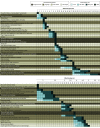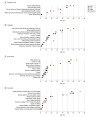Standardization of a Developmental Milestone Scale Using Data From Children in Israel
- PMID: 35285917
- PMCID: PMC9907346
- DOI: 10.1001/jamanetworkopen.2022.2184
Standardization of a Developmental Milestone Scale Using Data From Children in Israel
Abstract
Importance: Routine developmental screening tests for children are used worldwide for early detection of developmental delays. However, assessment of developmental milestone norms lacks strong normative data, and there are inconsistencies among different screening tools.
Objective: To establish milestone norms and build an updated developmental scale.
Design, setting, and participants: This is a cross-sectional, population-based study conducted between 2014 and 2020. Developmental assessments were conducted by trained public health nurses, documented in national maternal child health clinics, known as Tipat Halav, which serve all children in Israel. Participants included all children born between January 2014 and September 2020, who were followed at the maternal child health clinics from birth to age 6 years. Exclusion criteria were preterm birth, missing gestational age, low birth weight (<2.5 kg), abnormal weight measurement (<3% according to standardized child growth charts), abnormal head circumference measurement (<3% or >97% according to standardized child growth charts), and visits without developmental data or without the child's age. Data analysis was performed from September 2020 to June 2021.
Exposures: In total, 59 milestones in 4 developmental domains were evaluated, and the achievement rate per child's age was calculated for each milestone.
Main outcomes and measures: A contemporary developmental scale, the Tipat Halav Israel Screening (THIS) Developmental Scale, was built, presenting the 75%, 90%, and 95% achievement rates for each milestone. The THIS scale was compared with other commonly used screening tests, including the Denver Developmental Screening Test II (Denver II), the Alberta Infant Motor Scale (AIMS), and the Centers for Disease Control and Prevention (CDC) Developmental Assessment.
Results: A total of 839 574 children were followed in the maternal child health clinics between January 2014 and September 2020 in Israel, and 195 616 children were excluded. A total of 3 774 517 developmental assessments were performed for the remaining 643 958 children aged 0 to 6 years (319 562 female children [49.6%]), resulting in the establishment of new developmental norms. In terms of the comparable milestones, THIS milestones had a match of 18 of 27 (67%) with the Denver II, 7 of 7 (100%) with AIMS, and 10 of 19 (53%) with the CDC Developmental Assessment. The remaining unmatched milestones were achieved earlier in the THIS scale compared with other screening tools.
Conclusions and relevance: The THIS developmental scale is based on the largest population evaluated to date for developmental performance, representing the heterogeneous, multicultural population comprising this cohort. It is recommended for further evaluation worldwide.
Conflict of interest statement
Figures



References
-
- US Department of Health and Human Services . Birth to 5: watch me thrive! a compendium of screening measures for young children. Updated July 16, 2018. Accessed February 8, 2022. https://eclkc.ohs.acf.hhs.gov/publication/birth-5-watch-me-thrive-compen...
-
- Lipkin PH, Macias MM; Council on Children With Disabilities, Section on Developmental and Behavioral Pediatrics . Promoting optimal development: identifying infants and young children with developmental disorders through developmental surveillance and screening. Pediatrics. 2020;145(1):e20193449. doi:10.1542/peds.2019-3449 - DOI - PubMed

